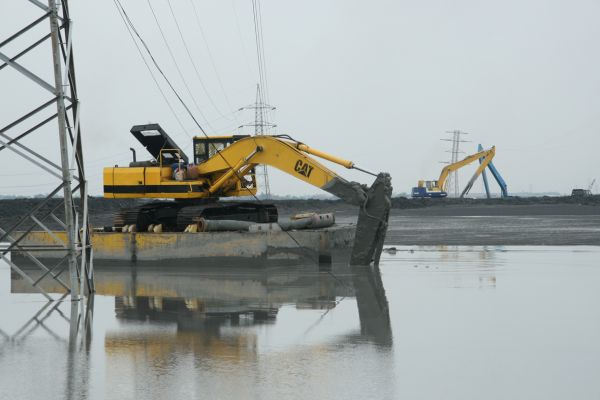Sarah Rennie
Bambang’s real life nightmare began on 28 May 2006 when the mining company Lapindo was drilling at the Banjar-Panji 1 exploration well in the district of Porong, Sidoarjo, East Java. A huge explosion deep within the earth caused vast quantities of hot mud to erupt from the mine and spread rapidly across the surrounding district (see ‘Un-natural disaster ’ and Postcards from a wasteland ).
The site of the disaster is now a sea of mud. |
By June Bambang’s home was disappearing from sight, as tens of thousands of cubic metres of toxic mud inundated his village. Along with several thousand other residents of Renokenongo and surrounding villages, he and his family were forced to flee to the nearby Pasar Porong Baru market development site. The following year Bambang embarked on a gruelling campaign to seek compensation from Lapindo. He travelled to Jakarta to try to negotiate with heads of government and company executives, but had little luck. This legal and political battle is not the only obstacle faced by Bambang and other mud-flow refugees. On the day we met at the refugee post in Pasar Porong, Bambang was pressed by more urgent concerns.
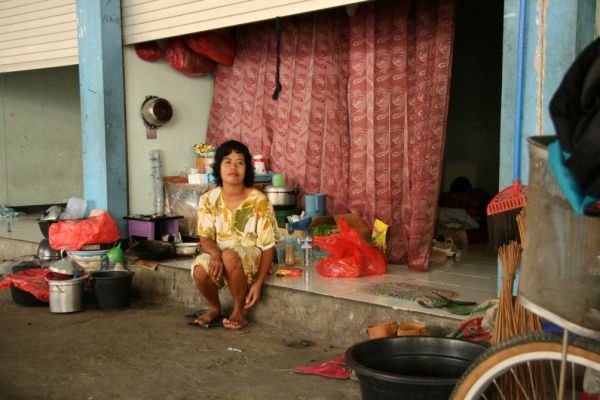 |
A woman sits in front of her new home. |
Confusion and uncertainty
Bambang’s face showed no emotion when he told us that his mother had been discovered unconscious on the floor of the amenities block at Pasar Porong that morning. His eyes, however, told a different story. His mother had passed away, and his grief was compounded by uncertainty. Where was he to bury her, now that their family cemetery had disappeared beneath layers of toxic mud? Where would he find the two million rupiah ($A230) required to purchase a piece of land for a gravesite when he had lost both his former home and his employment?
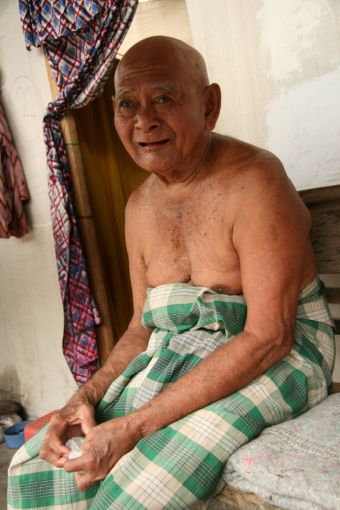 |
Tahub feels overwhelmed by his wife’s illness and living conditions
|
In the past 14 months at Pasar Porong 18 residents have passed away. It is at times like this that they feel most hopeless, their anguish exacerbated by confusion and homelessness.
The 2400 refugees who are still living in cramped conditions in tents and vacant stalls at Pasar Porong are a resilient lot. Many other mud-flow victims have largely given up trying to demand full compensation from Lapindo. Juno, an ojek (motorbike transportation) driver who works on the nearby Malang-Surabaya highway, accepted Lapindo’s offer of less than 20 per cent of land value as compensation allocated in a specific form of rent assistance. He signed the contract because he wanted to provide his wife and two children with a better place to live, but he worries about the long-term consequences. ‘Lapindo promised us that they would pay the remaining 80 per cent in the next two or maybe three years,’ Juno explained, ‘but actually I’m not sure. The whole agreement is uncertain.’
Fighting for survival
Pasar Porong is the base of the Pagar Rekontrak movement, a group of villagers who reject the housing contract offer from Lapindo and refuse to hand over their land certificates without compensation for one hundred per cent of the land’s value. They are not willing to make any more compromises; after all, they have lost more than just their land. Besides the hardship and trauma of losing their houses, factories, jobs and schools, they have also suffered the loss of their community. ‘Our neighbourhoods are now dispersed,’ said Bambang. ‘We are living at Pasar Porong or with relatives, or renting houses in other villages. Many of us have had to move far away to find new employment.’ The villagers associated with Pagar Rekontrak are prepared to stand up for their right to proper compensation for their land, even if it means they must continue to live as refugees at Pasar Porong.
Besides the trauma of losing their houses, factories, jobs and schools, they have also suffered the loss of their community
But as another wet season passes they are finding conditions at Pasar Porong increasingly difficult to endure. Unemployment has meant that families have been forced to sell off all their belongings. Women have traded their last pieces of jewellery to pay school fees and transport costs as their children travel further to new schools. There is no safe water supply at Pasar Porong, so they also have to purchase tanks without any government assistance. Toilet and shower facilities at the market are still inadequate and in the mornings children have to line up for hours to have a wash.
Physical and mental torment
Some food has been provided by the regional government in a program funded by Lapindo, but this food service has become another source of discontent. Every day identical packages, consisting of rice, a bite-sized piece of fried fish and a morsel of cabbage, are provided by the Centre for Food Aid. As emergency food, the package is passable, but when the state of emergency has lasted for well over a year, the provision of such meagre meals is intolerable. A woman in the open air kitchen at Pasar Porong unwrapped a package of the food for us to see. ‘They provide the same food for everyone, from babies to the elderly,’ she explained. ‘Old people really need lots of vegetables. This kind of food is not nutritious. Not hygienic either. So we usually don’t eat it. We’d rather buy our own food and cook for ourselves.’
In an incident earlier last year, the food provided was found to be rotten. Since that time many of the women just dry the rice in the sun and then sell it for krupuk (rice crackers) or chicken food.
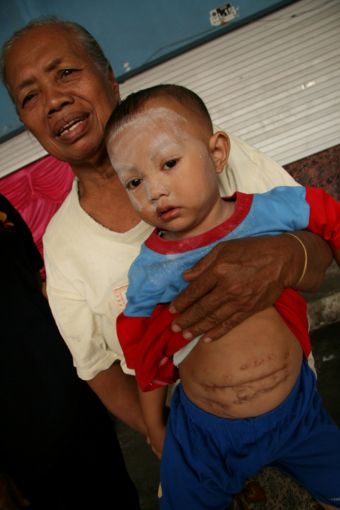 |
Three year old Hariyanto has undergone several operations for a
|
Sickness is another ongoing problem for the refugees at Pasar Porong. Many residents suffer from chest problems and asthma, which they believe is caused by the pollution blown across the highway from the Lapindo site. Infant health is also a matter of concern. Three year old Hariyanto has undergone three operations to correct a hernia that he developed while living at Pasar Porong. Hariyanto’s mother claims that the food at the camp exacerbated his illness, pointing to his bloated stomach and its barbed wire-like scarring.
For many mud-flow victims, it is the mental scarring from the traumatic events of 2006 that will take longest to heal. On the afternoon of our visit an elderly refugee, Tahub, sat outside his tent, his empty eyes staring off into the distance. Inside the tent his wife was itchy and agitated. Ten, 20, 100 times a day she asks when they will return to their village. Even though she has seen the grey barren mud plain across the highway with her own two eyes she refuses to accept that her home lies beneath it. She is not the only one who suffers from post-traumatic stress. Several victims of the mud-flow have experienced nervous breakdowns and panic attacks. These mental health issues present a more difficult challenge to the refugee community in Pasar Porong. As long as they remain in the refuge, their lives are fraught with uncertainty.
Out of the muddy void
In many ways the Lapindo disaster victims have fallen into a muddy void. Unlike the victims of natural disasters like earthquakes and tsunamis, they have not attracted wide public sympathy nor have they received significant government aid. The refugees have also been denied recognition as victims of a catastrophic corporate crime. A recent court ruling dismissed the lawsuit spearheaded by environmental organisation Walhi on the grounds that there was insufficient evidence to show that the mud-flow was a man-made disaster. Walhi plans to appeal this decision but in the meantime the East Java police have dropped their investigations into the matter, announcing they no longer have plans to press any charges.
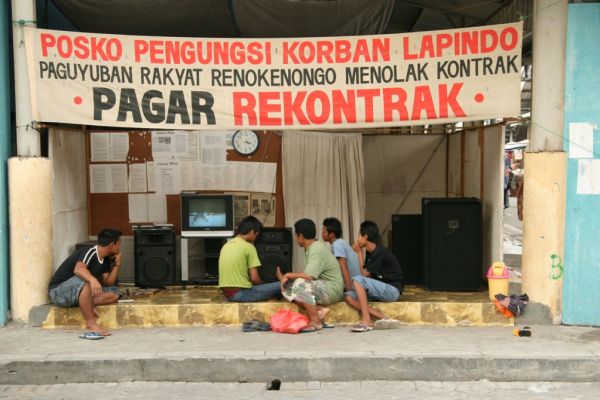 |
The Pagar Rekontrak office is the headquarters of a movement of villagers determined to fight for their rights. |
So what options remain open to mud-flow refugees and those involved in the Pagar Rekontrak movement? Sudarto, who showed us around the Pasar Porong camp, turned to face us with a smile sparkling with irony as he announced, ‘Did I say the government has done nothing? I was mistaken. The government did come up with one alternative solution. They have invited us to join a transmigration program to Kalimantan to become palm oil farmers!’
For many mud-flow victims the mental scarring will take longest to heal
Still, rather than losing hope, advocates like Bambang and Sudarto have turned their focus to attracting international legal assistance. They would like to have their case heard on the world stage. ‘We are currently raising funds to send a representative overseas to represent our cause,’ explained Bambang. ‘But one of our main obstacles is organising that trip. The government is making it very difficult for us to arrange travel documents, which just makes us feel cheated all over again.’
As dusk approaches dark storm clouds roll in over Pasar Porong and women hurry to take down washing before it is carried away by the howling wind. Bambang and his family sit waiting in their shelter, unable to depart for his mother’s funeral in the torrential rain. Suddenly the rain-drenched strip dividing rows of market stalls is flooded with the laughter of children, as they run around enjoying the entertainment provided by the ferocious storm. To see their colourful antics in such a moment of darkness brings smiles to the faces of Bambang’s family. At Pasar Porong there still exists a spirit that even the stormiest times cannot defeat. ii
Sarah Rennie (chillichompa@yahoo.com.au ) is an Asian Studies/Law student at the Australian National University, recently returned from an ACICIS exchange year at Gajah Mada University, Yogyakarta.
Jessica Lea Dunn (jessdunnthis@gmail.com ) is an Industrial Design and International Studies student at the University of Technology, Sydney, just returned from an ACICIS exchange year at Institut Seni Indonesia, Yogyakarta.
All photo credits: Jessica Lea Dunn
